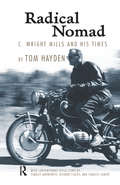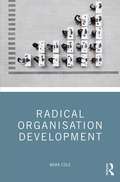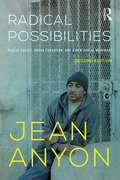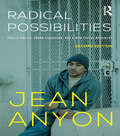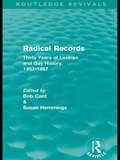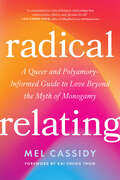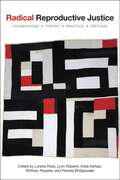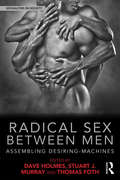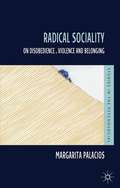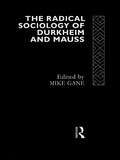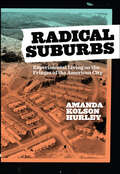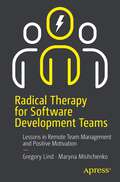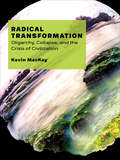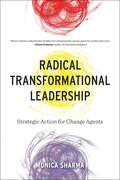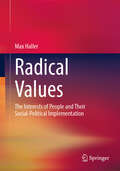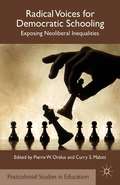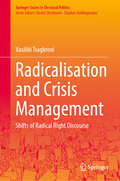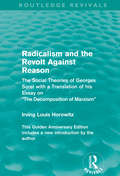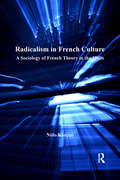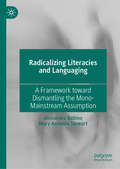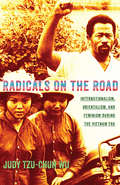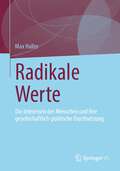- Table View
- List View
Radical Nomad: C. Wright Mills and His Times
by Tom HaydenNot long after co-authoring The Port Huron Statement, the charter document of sixties activism, Tom Hayden completed, at the University of Michigan, an intellectual biography of eminent scholar C. Wright Mills. It is published here for the first time, along with newly written essays by Hayden and by prominent social theorists who are experts on Mills and his ongoing influence today. Hayden cogently traces Mills' scholarship and his progressive activism to the events and thinkers of earlier generations. Ideas in major books by Mills (The Power Elite, New Men of Power, White Collar, Character and Social Structure, The Sociological Imagination) can now be better understood in light of the influences of Mills during and before his time, including the impact of two world wars, the Great Depression and the New Deal, the failures of the Soviet state, and changing relations between workers and industry in America and worldwide. The book thus brings us a new and much more complete understanding Mills's political theories and philosophy. With only one previous biography of Mills in print, this book is a major contribution to our understanding of C. Wright Mills in American intellectual life.
Radical Organisation Development
by Mark ColeContemporary organisation development (OD) in practice draws on sophisticated theory and tools to advance organisational change, using a range of concepts and techniques including positive psychology, appreciation, and active engagement with the workforce. OD is considered to be humanistic and, as a result, progressive. Mark Cole's original and thought-provoking treatise points at a hole at the heart of OD practice: it fails to consider the role of power in the workplace – and the result is disempowering. Drawing from critical theory as a radical means to redefine practice, Mark Cole exposes this paradox and reveals the significant limitations and negative impacts of current OD practice. We need to replace the idea of the organisation with a focus on active human organising to enable individuals within systems to effect change from the grassroots up: this concept is Radical OD. Essential reading for students, practitioners, and academics of OD; the wider HR community, and all with an interest in developing their understanding of organisational life, this ground-breaking manifesto offers unique and challenging insight into the corporate presence of OD – and challenges the willing reader to reimagine the focus and intent of this work.
Radical Possibilities: Public Policy, Urban Education, and A New Social Movement
by Jean AnyonThe core argument of Jean Anyon’s classic Radical Possibilities is deceptively simple: if we do not direct our attention to the ways in which federal and metropolitan policies maintain the poverty that plagues communities in American cities, urban school reform as currently conceived is doomed to fail. With every chapter thoroughly revised and updated, this edition picks up where the 2005 publication left off, including a completely new chapter detailing how three decades of political decisions leading up to the “Great Recession” produced an economic crisis of epic proportions. By tracing the root causes of the financial crisis, Anyon effectively demonstrates the concrete effects of economic decision-making on the education sector, revealing in particular the disastrous impacts of these policies on black and Latino communities.
Radical Possibilities: Public Policy, Urban Education, and A New Social Movement (Critical Social Thought Ser.)
by Jean AnyonThe core argument of Jean Anyon’s classic Radical Possibilities is deceptively simple: if we do not direct our attention to the ways in which federal and metropolitan policies maintain the poverty that plagues communities in American cities, urban school reform as currently conceived is doomed to fail. With every chapter thoroughly revised and updated, this edition picks up where the 2005 publication left off, including a completely new chapter detailing how three decades of political decisions leading up to the “Great Recession” produced an economic crisis of epic proportions. By tracing the root causes of the financial crisis, Anyon effectively demonstrates the concrete effects of economic decision-making on the education sector, revealing in particular the disastrous impacts of these policies on black and Latino communities. Going beyond lament, Radical Possibilities offers those interested in a better future for the millions of America’s poor families a set of practical and theoretical insights. Expanding on her paradigm for combating educational injustice, Anyon discusses the Occupy Wall Street movement as a recent example of popular resistance in this new edition, set against a larger framework of civil rights history. A ringing call to action, Radical Possibilities reminds readers that throughout U.S. history, equitable public policies have typically been created as a result of the political pressure brought to bear by social movements. Ultimately, Anyon’s revelations teach us that the current moment contains its own very real radical possibilities.
Radical Records: Thirty Years of Lesbian and Gay History, 1957-1987 (Routledge Revivals)
by Bob Cant Susan HemmingsThe period between the publication in 1957 of the liberalising Wolfenden Report and the introduction in 1987 of the homophobic Section 28 was characterised by unprecedented optimism and political activism among lesbians and gay men in Britain. But the law and its shortcomings never determined their whole political and cultural agenda and Radical Records explores the diverse and sometimes conflicting attempts of lesbian and gay people to build a new world for themselves and those they loved. The contributors recount their own personal narratives of how they struggled to re-define their identities, to explore non-traditional expressions of intimacy, to reclaim public spaces, to engage with the HIV epidemic, to build alliances and, generally, to make radical transformations of their lives. The re-issue of this important work, first published in 1988, gives its readers an opportunity to re-visit that turbulent time through the voices of its participants.
Radical Relating: A Queer and Polyamory-Informed Guide to Love Beyond the Myth of Monogamy
by Mel CassidyA provocative, trauma-informed guide to post-monogamy—how to build liberated relationships rooted in empowerment, equity, and authenticity With practical somatic exercises, reflection prompts and a relational toolkit—also includes a glossary of polyamory, non-monogamy, and alternative relationship termsThis book is for polyamorists who want to practice their non-monogamy with more feminism, more queerness, and more community building. It&’s for monogamists who don&’t want to do relationships on autopilot. It&’s for everyone who dearly believes a better way to love and live exists. It&’s for change makers who aspire to re-wild the ways we love.An empowering guide to imagining (and living) better relationships, Radical Relating pushes back on the monogamy mandate. Author, somatic educator, and relationship coach Mel Cassidy explodes the often-unquestioned mainstream myths about the nuclear family structure: those that tell us your soulmate must be your sole mate. That sex is the only yardstick of relational success. That self-sacrifice and self-denial are necessary trade-offs for security and partnership. That we need to ride the relationship escalator all the way up, or we&’ll die alone.In four sections, Cassidy explains the why, what, how, and where of the Radical Relating model. They:Lay out clear-eyed analysis about why monogamy isn&’t working and explain the harms of unquestioned internalized mono-normativityOffer Reflective Journaling prompts, Somatic Pauses, and practical wisdom for assembling your Relational ToolkitExplain the trauma-informed pillars of Radical Relating: Orientation, Resilience, Resolution, and EngagementHelp you reorient to a new map for relating that&’s queer, anarchist, and somatically integratedHelp you build skills to understand and navigate your relationship landscapeExplore the intersections of monogamy, colonialism, patriarchy, and capitalism and illuminate how monogamous relationship structures emerged with one goal in mind: to consolidate capitalMost books on non-monogamy focus on top-level logistics and play into beliefs that can inadvertently replicate oppressive structures. Radical Relating is different: it speaks to readers who want not only to open up their relationships or expand their sexual experiences, but claim a new and liberating ways to relate to each other, fulfill our authentic needs, and build true communities of care beyond monogamy.
Radical Reproductive Justice: Foundation, Theory, Practice, Critique
by Loretta Ross Erika Derkas Whitney PeoplesPractical tools and theoretical frameworks for understanding the fight for reproductive rights, from pregnancy to parenthood and beyond. Expanding the social justice discourse surrounding "reproductive rights" to include issues of environmental justice, incarceration, poverty, disability, and more, this crucial anthology explores the practical applications for activist thought on this ever-urgent issue. Radical Reproductive Justice assembles two decades’ of work initiated by SisterSong Women of Color Health Collective, creators of the human rights-based “reproductive justice” framework to move beyond polarized pro-choice/pro-life debates. Rooted in Black feminism and built on intersecting identities, this revolutionary framework asserts a woman's right to have children, to not have children, and to parent and provide for the children they have. “The book is as revolutionary and revelatory as it is vast." —Rewire
Radical Sex Between Men: Assembling Desiring-Machines (Sexualities in Society)
by Dave Holmes Stuart J. Murray Thomas FothBringing together theory and public health practice, this interdisciplinary collection analyses three forms of nonconventional or radical sexualities: bareback sex, BDSM practices, and public sex. Drawing together the latest empirical research from Brazil, Canada, Spain, and the USA, it mobilizes queer theory and poststructuralism, engaging the work of theorists such as Bataille, Butler, Deleuze and Guattari, and Foucault, among others. While the collection contributes to current research in gender and sexuality studies, it does so distinctly in the context of empirical investigations and discourses on critical public health. Radical Sex Between Men: Assembling Desiring-Machines will be of interest to advanced undergraduate students, postgraduate students, and researchers in gender and sexuality studies, sexology, social work, anthropology, and sociology, as well as practitioners in nursing, medicine, allied health professions, and psychology.
Radical Social Change in the United States
by Joanna SwangerThis book tackles the question of why the United States is so resistant to radical change towards economic justice and peace. Taking full stock of the despair that launched the popular support for Bernie Sanders and Donald Trump, Swanger historicizes the political paralysis of post-1974 United States that deepened already severe economic inequalities, asking how the terrain for social movements in the early twenty-first-century US differs from that of the 1960s. This terrain is marked by the entrenchment of neoliberalism, anti-intellectualism, and difficulties paradoxically posed by the ease of social media. Activists now must contend with a paralyzing "post-factual" moment. Alain Badiou's thought informs this book on breaking through contemporary political paralysis.
Radical Social Change in the United States: Badiou's Apostle and the Post-Factual Moment
by Joanna SwangerThis book tackles the question of why the United States is so resistant to radical change towards economic justice and peace. Taking full stock of the despair that launched the popular support for Bernie Sanders and Donald Trump, Swanger historicizes the political paralysis of post-1974 United States that deepened already severe economic inequalities, asking how the terrain for social movements in the early twenty-first-century US differs from that of the 1960s. This terrain is marked by the entrenchment of neoliberalism, anti-intellectualism, and difficulties paradoxically posed by the ease of social media. Activists now must contend with a paralyzing “post-factual” moment. Alain Badiou’s thought informs this book on breaking through contemporary political paralysis.
Radical Sociality
by Margarita PalaciosA philosophical and psychoanalytic investigation of relations to otherness, violence, disobedience and belonging, Radical Sociality explores the possibilities and vicissitudes of contemporary forms of belonging and the limits and challenges of democracy.
Radical Sociology of Durkheim and Mauss
by Mike GaneIn this outstanding collection, Mike Gane brings together a selection of key articles on Durkheim and Mauss showing their points of convergence and divergence. Included here are Mauss's 'A sociological assessment of Bolshevism 1924-5' and his 'Letters on Communism, Fascism and Nazism'. This is an engrossing book not only for scholars and students of Durkheim and Mauss but for anyone interested in radical social theory.
Radical Suburbs: Experimental Living on the Fringes of the American City
by Amanda Kolson Hurley&“A revelation . . . will open your eyes to the wide diversity and rich history of our ongoing suburban experiment.&” —Richard Florida, author of The Rise of the Creative Class America&’s suburbs are not the homogenous places we sometimes take them for. Today&’s suburbs are racially, ethnically, and economically diverse, with as many Democratic as Republican voters, a growing population of renters, and rising poverty. The cliche of white picket fences is well past its expiration date. The history of suburbia is equally surprising: American suburbs were once fertile ground for utopian planning, communal living, socially-conscious design, and integrated housing. We have forgotten that we built suburbs like these, such as the co-housing commune of Old Economy, Pennsylvania; a tiny-house anarchist community in Piscataway, New Jersey; a government-planned garden city in Greenbelt, Maryland; a racially integrated subdivision (before the Fair Housing Act) in Trevose, Pennsylvania; experimental Modernist enclaves in Lexington, Massachusetts; and the mixed-use, architecturally daring Reston, Virginia. Inside Radical Suburbs you will find blueprints for affordable, walkable, and integrated communities, filled with a range of environmentally sound residential options. Radical Suburbs is a history that will help us remake the future and rethink our assumptions of suburbia. &“The communities Kolson Hurley chronicles are welcome reminders that any place, even a suburb, can be radical if you approach it the right way.&” —NPR &“Radical Suburbs overturns stereotypes about the suburbs to show that, from the beginning, those &‘little boxes&’ harbored revolutionary ideas about racial and economic inclusion, communal space, and shared domestic labor. Amanda Kolson Hurley&’s illuminating case studies show not just where we&’ve been but where we need to go.&” ―Alexandra Lange, author of The Design of Childhood
Radical Therapy for Software Development Teams: Lessons in Remote Team Management and Positive Motivation
by Gregory Lind Maryna MishchenkoBuild and maintain effective, collaborative, and motivated software development teams. This book addresses the challenges in doing so, like communication gaps, trust issues, and motivation problems, and provides strategies to overcome them. You'll be introduced to the Radical Therapy Dev philosophy, a holistic approach designed to optimize software development teams for better performance and overall well-being. This book highlights common pain points in software development and offers solutions to resolving much of the issues in teams. It offers strategies for implementation, focusing on adaptability and accountability, while also promoting community-supported standards. And, the book reveals why an emphasis on fostering a growth mindset, mentorship programs, and junior-intern initiatives promotes continuous learning and collaboration.With the rise of remote work, you'll see why hiring globally while thinking locally is gaining popularity. You'll also gain insights into removing barriers to remote work, along with tools and policies for remote collaboration. Additionally, the book explores the concept of cloud-native software development and its benefits. Radical Therapy for Software Development Teams critiques the traditional "agile" methodology, identifying its shortcomings while extracting valuable lessons that can still be applied effectively. What You Will LearnAddress communication gaps, foster trust, and nurture a growth mindset among team membersAvoid common feedback mistakes, recognize accomplishments, and implement a reward systemImprove software development practices and team dynamics Take a scientific approach to project management rather than traditional requirements gatheringBreak Down Communication BarriersWho This Book is ForSoftware development professionals
Radical Transformation: Oligarchy, Collapse, and the Crisis of Civilization
by Kevin MacKayRadical Transformation is a story about industrial civilization’s impending collapse, and about the possibilities of averting this fate. Human communities first emerged as egalitarian, democratic groups that existed in symbiotic relationship with their environments. Increasing complexity led to the emergence of oligarchy, in which societies became captive to the logic of domination, exploitation, and ecological destruction. The challenge facing us today is to build a movement that will radically transform civilization and once more align our evolutionary trajectory in the direction of democracy, equality, and ecological sustainability.
Radical Transformational Leadership: Strategic Action for Change Agents
by Monica SharmaMonica Sharma describes how we can source our inner capacities and wisdom to manifest change that embodies universal values such as dignity, compassion, fairness, and courage. Drawing on more than twenty years of work for the United Nations and elsewhere, she presents a radical new approach to transformational leadership, one that creates systems of change where everyone can engage—not just analysts and policy-makers. Demonstrating that we all can be architects of a new humanity, Monica demystifies policy-making, planning, and implementation so that everyone can play an informed and strategic part in eradicating the world’s most intractable problems. Using real-life examples from around the world, she shows how our innate characteristics of universal compassion, equity impulse, and human capability can create new patterns that effectively address major challenges such as gross inequality, unbridled hate, conflicts based on social identity, and the never-enough mindset of greed. Written in a straightforward, accessible style, Radical Transformational Leadership outlines a path-breaking paradigm shift that is already generating equitable and sustainable results across the globe.
Radical Values: The Interests of People and Their Social-Political Implementation
by Max HallerA famous and frequently quoted sentence by Max Weber states: &“Interests, not ideas, directly govern the actions of people. However, the &‘worldviews&’ created by &‘ideas&’ have often determined the paths in which the dynamics of interests propelled action.&” Recent sociology, however, has not done justice to this principle. Values and their effects are either assumed to be given (as in the case of Talcott Parsons) or considered entirely irrelevant (as in Rational Choice and System Theory). Extensive empirical research on values has yielded many results but has largely lacked a theoretical foundation, making its findings often contestable. Weber himself provided only unsatisfactory answers regarding the relevance of values: The decision for specific values is a purely individual matter, and there is an irreconcilable struggle between different values. This book comprehensively examines this issue for the first time in sociology and finds a new, constructive, and explanatory solution - drawing on authors such as Immanuel Kant, George H. Mead, and Raymond Boudon. It is utilizing considerations from philosophy, social theory, and empirical social research, as well as incorporating historical struggles for the recognition and enforcement of values. It can be determined that there are fundamental societal values, that their number can be clearly defined, and that there is not necessarily conflict between them, but rather complementarity. With these theses and findings, this book can be regarded as a new sociological standard work. It is also of fundamental importance for students and researchers in many other humanities and social science disciplines.
Radical Voices for Democratic Schooling: Exposing Neoliberal Inequalities (Postcolonial Studies in Education)
by P. Orelus C. MalottComprised of in-depth interviews and conversations with key figures in education and activism that thoroughly examine the intersection of neoliberalism, neocolonialism, and racism, this first-rate collection critically explores, through their teaching, various, important issues situated in the context of Western neoliberalism and neocolonialism.
Radicalisation and Crisis Management: Shifts of Radical Right Discourse (Springer Series in Electoral Politics)
by Vasiliki TsagkroniThis book discusses theories of crisis management and the radical right, to shed light on how responses to crisis influence radical right parties in their presence, discourse, and evolution. The book offers a comparative perspective by examining case studies with various traditions of radical right actors, presenting data on how crisis exploitation can assist in exploring, reconsidering, bargaining, and learning about the prospects of change of political parties. The book focuses on the debate on radicalization and crisis management. Similar to the already existing economic, political, post-Brexit, and migration crises in Europe, discourses of fear around the latest health crisis are paving the way for further radicalised discourse from the far right. The book looks into how radical right parties in Europe have responded to these crises. It monitors and explores how crisis exploitation impacts political strategies, opportunity-seeking behaviours, and the evolution of the discourse of radical right parties in the contemporary political landscape. Therefore, this book is a must-read for researchers, students, and policy-makers, interested in a better understanding of populism, radical right parties, electoral studies, as well as comparative politics in general.
Radicalism and the Revolt Against Reason: The Social Theories of Georges Sorel with a Translation of his Essay on the Decomposition of Marxism (Routledge Revivals)
by Irving Louis HorowitzRadicalism and the Revolt Against Reason is a work that continues to have a steady and large scale impact on political and social theory fifty years since its first appearance. A study of how radical thought modifies its actions and ideologies in a time of unrealized and frustrated expectations, the focus is on Georges Sorel and the Europe of the fin de siècle, a time when socialist revolution was forcefully set aside by liberal reform. In a technique that presaged contemporary period, radical demands did not simply dissolve or disappear, they profoundly changed emphasis from the impersonal forces of history to highly personal forces of individual will. This edition includes a substantial brand new introduction by the author.
Radicalism in French Culture: A Sociology of French Theory in the 1960s (Public Intellectuals and the Sociology of Knowledge)
by Niilo KauppiAn invisible pattern draws together most studies dealing with French cultural radicalism in the 1960s with intellectual creation reduced to individual creation and the role of semiotic and social factors that influence intellectual innovation minimized. Sociological approaches often see a more or less external link between social location and intellectual production but, because of their structural approach, they are incapable of taking into account unique historical circumstances, the crucial role of personal impulses, and more importantly the semiotic logic of ideas as conditions of innovative thinking. This ground-breaking book will further an internal sociological analysis of ideas and styles of thought. It will show that the defining but largely neglected feature of what has become "French theory" was a collective mind and style of thought, an explosive but fragile mixture of scientific and political radicalism that rather quickly watered down to academic orthodoxy. For some time, radical intellectuals succeeded in producing ideas that were perfectly in tune with the demands of the consumers, mostly the young university audience. Ideas were used as part of radical posture that was set in opposition to the establishment and "those in power". Ideas could not be too empirical or verifiable, and they had to shock. It is not surprising that a slew of new sciences and concepts were invented to indicate this radical posture. The central argument of this study is that ideas become "power-ideas" only if they succeed in uniting individual and collective psychic investment in powerful social networks with significant institutional and political backing. These conditions were met in the French context for a certain specific period of time. From roughly the mid-1960s to the beginning of the 1970s, radical intellectuals such as Roland Barthes, Pierre Bourdieu, Jacques Derrida, Michel Foucault, Julia Kristeva developed a host of new ideas, concepts and theories, a number of which have subsequently been labelled as French theory.
Radicalizing Literacies and Languaging: A Framework toward Dismantling the Mono-Mainstream Assumption
by Mary Amanda Stewart Alexandra BabinoThis book names and confounds the mono-mainstream assumption that invisibly frames much research, the ideologies that normalize monolingualism, monoculturalism, monoliteracy, mononationalism, and/or monomodal ways of knowing. In its place, the authors propose multi- and trans- lenses of these phenomena steeped in a raciolinguistic perspective on Bourdieu’s reflexive sociology to move toward a more accurate, multidimensional view of racialized peoples’ literacy and language practices. To achieve this, they first engage in a comprehensive review of literacies, languaging, and a critical sociocultural framework. Then, the distinct testimonios of four women underscore this framework in practice, followed by action steps for research, policy, and pedagogy. This book will be of particular interest to literacy and language education researchers.
Radicals On The Road: Internationalism, Orientalism, and Feminism during the Vietnam Era (The United States in the World)
by Judy Tzu-Chun WuTraveling to Hanoi during the U. S. war in Vietnam was a long and dangerous undertaking. Even though a neutral commission operated the flights, the possibility of being shot down by bombers in the air and antiaircraft guns on the ground was very real. American travelers recalled landing in blackout conditions, without lights even for the runway, and upon their arrival seeking refuge immediately in bomb shelters. Despite these dangers, they felt compelled to journey to a land at war with their own country, believing that these efforts could change the political imaginaries of other members of the American citizenry and even alter U. S. policies in Southeast Asia. In Radicals on the Road, Judy Tzu-Chun Wu tells the story of international journeys made by significant yet underrecognized historical figures such as African American leaders Robert Browne, Eldridge Cleaver, and Elaine Brown; Asian American radicals Alex Hing and Pat Sumi; Chicana activist Betita Martinez; as well as women's peace and liberation advocates Cora Weiss and Charlotte Bunch. These men and women of varying ages, races, sexual identities, class backgrounds, and religious faiths held diverse political views. Nevertheless, they all believed that the U. S. war in Vietnam was immoral and unjustified. In times of military conflict, heightened nationalism is the norm. Powerful institutions, like the government and the media, work together to promote a culture of hyperpatriotism. Some Americans, though, questioned their expected obligations and instead imagined themselves as "internationalists," as members of communities that transcended national boundaries. Their Asian political collaborators, who included Buddhist monk Thich Nhat Hanh, Foreign Minister of the Provisional Revolutionary Government Nguyen Thi Binh and the Vietnam Women's Union, cultivated relationships with U. S. travelers. These partners from the East and the West worked together to foster what Wu describes as a politically radical orientalist sensibility. By focusing on the travels of individuals who saw themselves as part of an international community of antiwar activists, Wu analyzes how actual interactions among people from several nations inspired transnational identities and multiracial coalitions and challenged the political commitments and personal relationships of individual activists.
Radikale Werte: Die Interessen der Menschen und ihre gesellschaftlich-politische Durchsetzung
by Max HallerEin berühmter, immer wieder zitierter Satz von Max lautet: „Interessen (materielle und ideelle), nicht: Ideen, beherrschen unmittelbar das Handeln der Menschen. Aber: die ‚Weltbilder‘, welche durch ‚Ideen‘ geschaffen wurden, haben sehr oft als Weichensteller die Bahnen bestimmt, in denen die Dynamik der Interessen das Handeln fortbewegte.“ Die neuere Soziologie ist diesem Grundsatz allerdings nicht gerecht geworden. Werte und ihre Wirkung werden entweder als gegeben vorausgesetzt (so bei Talcott Parsons) oder überhaupt als irrelevant betrachtet (so in der Rational Choice- und Systemtheorie). Die umfangreiche, empirische Werteforschung hat vielfältige Ergebnisse erbracht, blieb jedoch weitgehend ohne theoretisches Fundament, sodass ihre Befunde vielfach anfechtbar sind. Weber selbst gab im Hinblick auf die Frage nach der Relevanz der Werte nur unbefriedigende Antworten: Die Entscheidung für bestimmte Werte sei eine rein individuelle Angelegenheit und zwischen den verschiedenenWerten gebe es einen unversöhnlichen Kampf. Im vorliegenden Buch wird diese Problematik erstmals in der deutschen Soziologie umfassend untersucht und es wird dafür (u.a. im Anschluss an Autoren wie Immanuel Kant, George H. Mead und Raymond Boudon), eine neue, konstruktive und erklärungsstarke Lösung gefunden. Unter Zuhilfenahme von Überlegungen aus Philosophie, Sozialtheorie und empirischer Sozialforschung sowie unter Einbeziehung historischer Kämpfe zur Anerkennung und Durchsetzung der Werte kann man feststellen, dass es gesellschaftliche Grundwerte gibt, dass deren Anzahl klar bestimmbar ist und dass zwischen ihnen keineswegs Konflikt, sondern Komplementarität besteht. Mit diesen Thesen und Befunden kann dieses Buch als neues soziologisches Standardwerk angesehen werden. Es hat auch für Vertreter vieler anderer geistes- und sozialwissenschaftlicher Disziplinen grundlegende Bedeutung.
Radio - The Forgotten Medium
by Everette E. Dennis Edward C. PeaseAlthough television is now dominant, radio surprisingly remains a medium of unparalleled power and importance. Worldwide, it continues to be the communications vehicle with the greatest outreach and impact. Every indicator - economic, demographic, social, and democratic - suggests that far from fading away, radio is returning to our consciousness, and back into the cultural mainstream.Marilyn J. Matelski reviews radio's glory days, arguing that the glory is not all in the past. B. Eric Rhoads continues Matelski's thoughts by explaining how and why radio has kept its vitality. The political history of radio is reviewed by Michael X. Delli Carpini, while David Bartlett shows how one of radio's prime functions has been to serve the public in time of disaster. Other contributors discuss radio as a cultural expression; the global airwaves; and the economic, regulatory, social, and technological structures of radio.Collectively, the contributors provide an intriguing study into the rich history of radio, and its impact on many areas of society. It provides a wealth of information for historians, sociologists, and communications and media scholars. Above all, it helps explain how media intersect, change focus, but still manage to survive and grow in a commercial environment.
